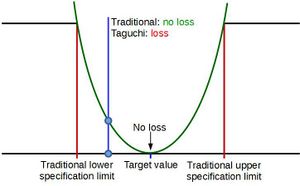Quality loss function
| Quality loss function |
|---|
| See also |
Quality loss function is a method of measuring losses that are incurred due to not perfect, however compliant production. The largest share in global losses of quality are these manifesting themselves in the longer term, related to consumer dissatisfaction, loss of market, increased stocks, performance drop, etc. In order to estimate them the quality loss function is used. The way the loss function is defined depends on the type of quality characteristics. The idea created by Genichi Taguchi revolutionized approach to product quality assurance.
Two types of factors interact with the functional characteristics of the product:
- Controllable, which can be easily inspected and maintained,
- Interfering, which control is difficult and often impossible.
These actions in any case are very expensive.
Interfering factors
You can extract the three basic types of interference:
- Outer noise, e.g.: resulting from the impact of weather conditions and environment,
- Inner noise, such as: ageing equipment, tolerances causing deterioration, between products noise that is caused by imperfections in manufacturing processes and cause deviations between individual copies of the product.
Interfering factors are responsible for the deviation of the functional characteristics of from the desired value. Because the measurement of these factors is expensive and often even impossible, in the Taguchi method we don't try to identify them, and then control, but rather select such values of controllable factors that minimize product and process sensitivity to changes in interfering factors. Instead of seeking out and eliminating the causes, we try to reduce the impact of these causes. This type of procedure allows to create a product resistant to interference.
Method design
Parameters design is a key step in the Taguchi method, which can best satisfy the condition of improving quality without a relative increase in costs. This step is part of the design process under off-line quality control.
Activities related to the design of the system include:
- selection of materials and components,
- selection of test parameters of the product,
- choice of production equipment,
- choice of sample values of the process.
Design parameters include pre-trial testing of fixed nominal values and based on testing determining the best combination of performance levels of products and operative levels of indicators of the process, so that they are most resistant to changes in the external environment and to other confounding factors. Tolerance design is used in cases where the elimination of deviations achieved during the design parameters is unsatisfactory. The design determines the exact tolerances for these parameters or indicators of a product or process whose deviation from the desired (nominal) exert a strong influence on the final deviation. These activities involve funds for the purchase of better quality materials, components or devices.
The parameters design objective is to seek such nominal values for the controllable factors that meet the conditions for maximum compatibility of the product at the lowest cost and lowest susceptibility to interference. It is assumed to proceed as follows:
- identify controllable factors and interfering and consider them separately,
- conduct data analysis using the signal (controllable factor) to the noise ratio as a measure of performance (compliance)
The S/N signal is inversely proportional to the loss function, so the maximization of this ratio means minimizing losses while improving quality.
Although the Taguchi method due to its numerous advantages is propagated throughout the world, in practice only 1% of the engineers who are trained in its application fully uses it. The vast majority of American and Western European manufacturers in the design of products and manufacturing processes use only selected, usually quantitative elements of the method.
Taguchi formula
The loss generated by one unic is calculated using the formula
where:
- L(y) - the loss in currency
- k - a proportionality constant dependent upon the organization’s failure cost structure,
- y - actual value of quality characteristic,
- T - target value of quality characteristic,
- c - loss associated with the specification limit,
- d - deviation of the specification from the target value.
Asymmetric Quality Loss Function
The asymmetric quality loss function implies that variations can have different impact on loss level. If that happens, one side of the function will be different from another side (asymmetry). To establish loss of asymmetric function it is necessary to calculate each side's loss and then add them to get the result.
Examples of asymmetric QLF
- soft drink - symmetric, however small deviation will remain unnoticed,
- delivery time - asymmetric, early delivery usually has no effect,
- air pressure in tyres - asymmetric, too little pressure can destroy the tyre slowly, but too high will destroy it suddenly
References
- Quality loss function described in more mathematical way
- Ames, A.E. Mattucci, N. MacDonald, S. Szonyi, G. Hawkins, D.M. (1997) Quality loss functions for optimization across multiple response surfaces, Journal of Quality Technology 29.3: 339-346.
- Om Prakash Y., Sunil S.B., Ajay R. (2010) Reliability-based robust design optimization: A multi-objective framework using hybrid quality loss function, Quality and Reliability Engineering International, Volume 26, Issue 1
Author: Edyta Gwóźdź, Sławomir Wawak


